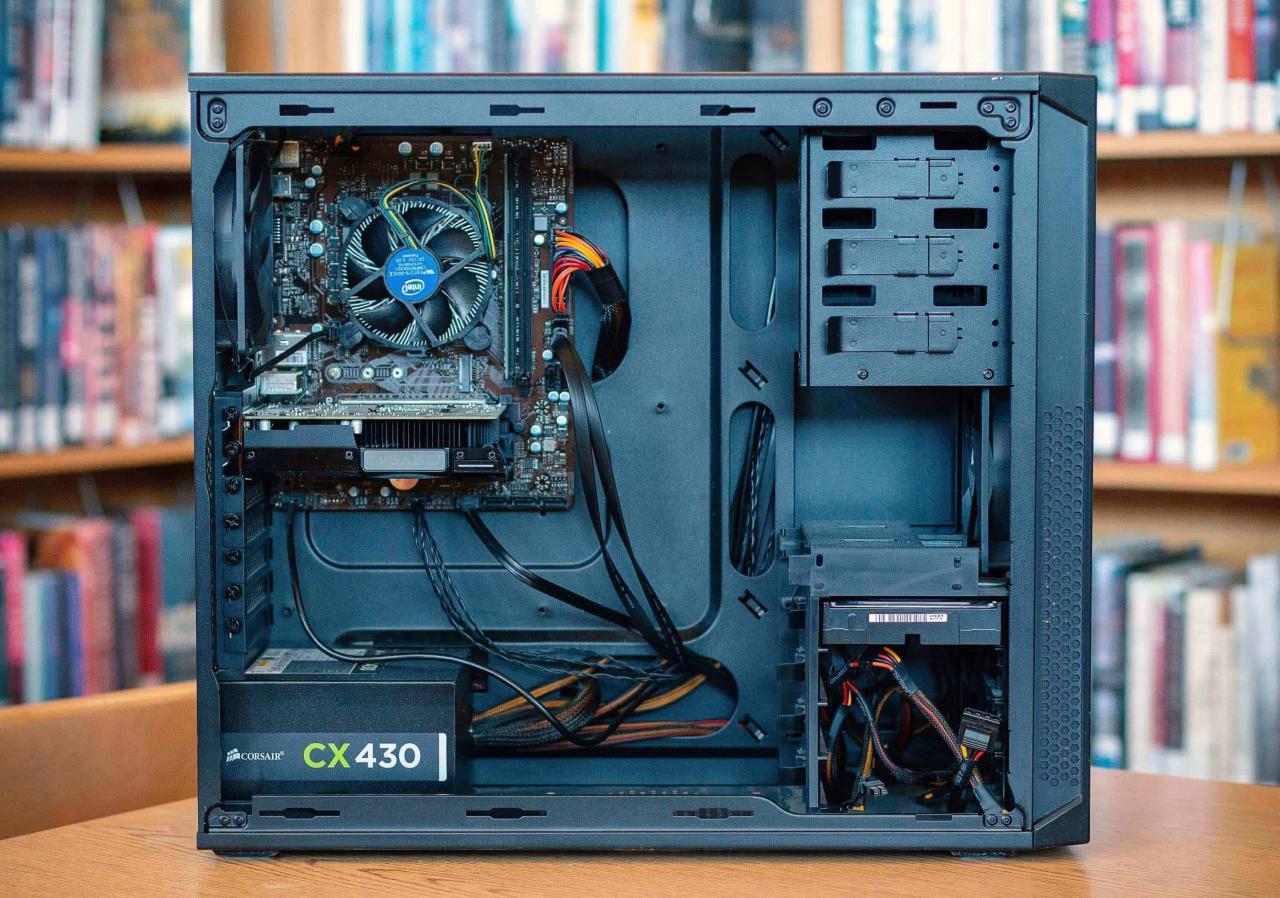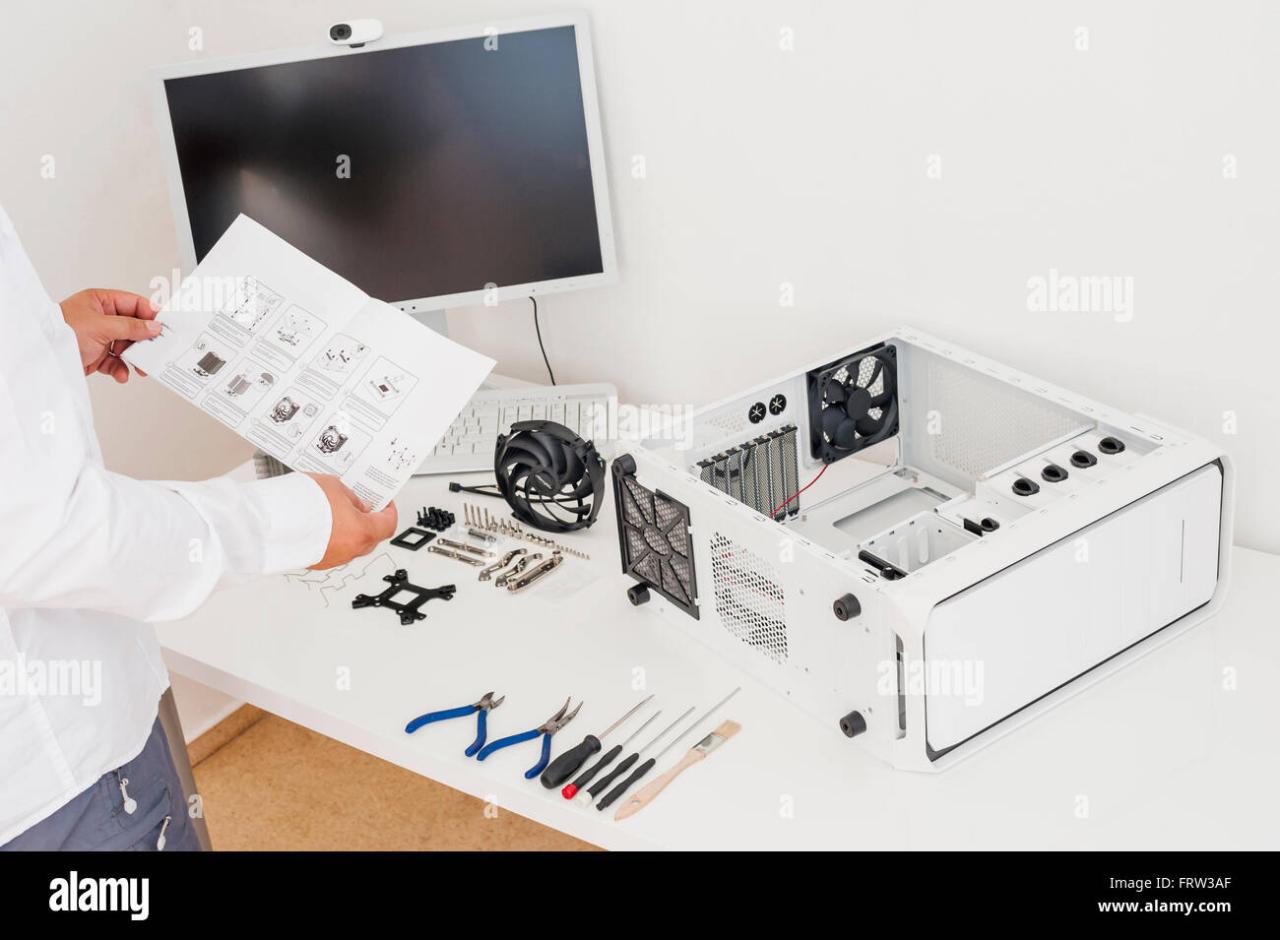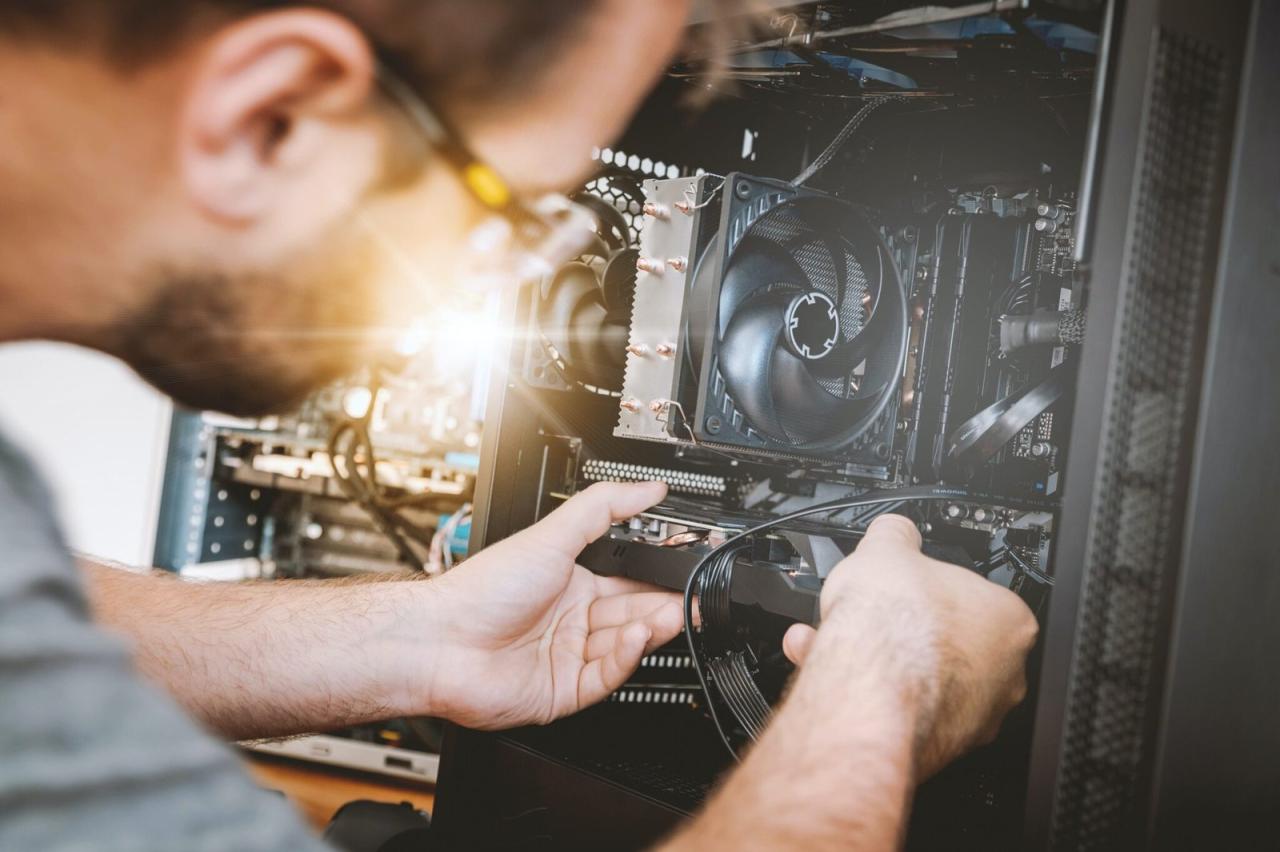PC Builder: Dive into the exciting world of custom computer building! From budget-friendly gaming rigs to high-end professional workstations, we’ll guide you through every step, from choosing the right components to troubleshooting common issues. Get ready to build the PC of your dreams!
This guide covers everything you need to know about building your own computer, whether you’re a seasoned tech enthusiast or a complete beginner. We’ll explore the different market segments, the PC building process, component selection, software installation, troubleshooting, and the future of PC building. We’ll break down complex topics into easy-to-understand steps, providing practical advice and solutions along the way.
Defining the PC Builder Market
The PC builder market is a diverse ecosystem encompassing various segments, key players, and a rich history of technological evolution. Understanding this landscape is crucial for anyone venturing into PC building, whether as a hobbyist or a professional.
Building your own PC can be a rewarding experience, letting you customize every aspect to your needs. If you’re looking for some extra cash to fund those high-end components, check out the awesome deals at this year’s drone Boxing Day sale ; maybe you can even sell your old drone to boost your budget. Then, get back to that sweet PC build!
Market Segmentation
The PC builder market can be broadly segmented based on user needs and budget. Budget builders prioritize affordability, often opting for entry-level components to create functional systems. Enthusiast builders focus on high-performance, investing in top-of-the-line components for gaming, content creation, or other demanding tasks. Professional builders cater to specific needs, such as workstation configurations for video editing or scientific simulations, demanding specialized components and configurations.
Key Players
Several key players contribute to the PC builder market’s dynamism. Component manufacturers like Intel, AMD, NVIDIA, and Samsung provide the core building blocks. Retailers such as Newegg, Amazon, and local computer stores offer various components and pre-built systems. Online communities like Reddit’s r/buildapc and various forums facilitate knowledge sharing, troubleshooting, and peer-to-peer support among builders.
Evolution of PC Building
PC building has undergone significant transformations. The early days (1970s-1980s) were characterized by bulky components and limited processing power. The rise of the IBM PC in the 1980s standardized the architecture, leading to increased accessibility. The 1990s witnessed the emergence of the internet and multimedia applications, demanding faster processors and graphics capabilities. The 2000s saw the proliferation of affordable high-performance components, enabling more widespread PC building.
The current era (2010s-present) is marked by miniaturization, increased energy efficiency, and the integration of advanced technologies like AI and machine learning in component design.
The PC Building Process: Pc Builder

Building a PC involves a systematic approach to component selection and assembly. Careful planning and execution are essential for a successful build.
Step-by-Step PC Building Guide
| Step | Action | Potential Challenges | Solutions |
|---|---|---|---|
| 1 | Component Selection | Choosing compatible components | Use online compatibility checkers and consult community forums. |
| 2 | CPU Installation | Damaging the CPU or socket | Carefully align the CPU and use appropriate pressure. |
| 3 | Motherboard Setup | Incorrectly installing RAM or other components | Consult the motherboard manual for detailed instructions. |
| 4 | GPU Installation | Improperly seating the GPU | Ensure the GPU is firmly seated in the PCIe slot. |
| 5 | Storage Installation | Incorrectly connecting SATA cables or power | Double-check connections and consult manuals. |
| 6 | Power Supply Installation and Wiring | Incorrectly connecting power cables | Carefully match power connectors to their corresponding components. |
| 7 | Cable Management | Poor cable management leading to overheating | Use cable ties and plan cable routing for optimal airflow. |
| 8 | Operating System Installation | Driver issues or boot failures | Use a bootable USB drive and follow the OS installation instructions. |
| 9 | Testing and Troubleshooting | System instability or errors | Check for loose connections, faulty components, and driver issues. |
Pre-built vs. Custom Builds

Pre-built systems offer convenience but often lack customization options and may come with less desirable components. Custom builds provide greater flexibility and control, allowing for optimized performance and tailored configurations, but require more technical expertise.
Component Compatibility
Component compatibility is crucial. For instance, using a CPU that requires a different socket type than the motherboard will render the system inoperable. Similarly, using RAM that exceeds the motherboard’s maximum supported speed will result in performance limitations.
Component Selection and Considerations
Choosing the right components is critical for optimal performance and system longevity. Several factors need to be considered when selecting each component.
CPU Selection
CPU selection depends on intended use. A high-core-count CPU is beneficial for multitasking and professional applications, while a high-clock-speed CPU excels in gaming. Consider factors such as core count, clock speed, cache size, and TDP (Thermal Design Power).
| Architecture | Manufacturer | Performance Characteristics |
|---|---|---|
| x86-64 | AMD, Intel | Widely compatible, high performance |
| ARM | Apple, Qualcomm | Energy-efficient, increasing performance |
Cooling Solutions
Effective cooling prevents overheating and ensures system stability. Options include air coolers (heatsinks and fans), liquid coolers (CPU and AIO), and custom loop water cooling systems. The choice depends on budget, performance needs, and noise tolerance.
So you’re thinking about building your own PC? That’s awesome! Building a PC can seem daunting, but it’s really rewarding. Check out this great resource to get started: pc builder. They’ve got tons of guides and tips to help you through every step, from choosing components to actually putting it all together. Once you’ve built your own PC, you’ll understand exactly how it works and you’ll have a machine perfectly tailored to your needs.
Performance vs. Cost Trade-offs
Balancing performance and cost is essential. Budget-friendly options may compromise performance, while high-performance components can significantly increase the build cost. Careful consideration of individual needs and budget constraints is necessary.
Software and Operating Systems
The operating system (OS) is the foundation of PC functionality. Choosing the right OS and optimizing its performance is crucial for a smooth user experience.
Operating System Roles and Comparisons
Operating systems manage hardware resources, provide a user interface, and run applications. Windows remains the most prevalent OS for gaming and general use, while macOS is favored for its user-friendly interface and stability. Linux distributions offer flexibility and customization but require a steeper learning curve.
Operating System Installation
Installing an OS typically involves creating a bootable USB drive with the OS installer, booting from the USB drive, and following the on-screen instructions. This process includes partitioning the hard drive and selecting the installation location.
- Create a bootable USB drive.
- Boot from the USB drive.
- Follow the on-screen instructions to install the OS.
- Install necessary drivers after the OS installation is complete.
PC Performance Optimization, Pc builder

Optimizing PC performance involves tasks such as installing necessary drivers, updating the OS, removing unnecessary programs, and adjusting power settings. Regular maintenance and updates are crucial for system stability and performance.
Troubleshooting and Maintenance
Troubleshooting and regular maintenance are vital for keeping your PC running smoothly. Identifying and addressing issues promptly prevents more significant problems.
Common Problems and Solutions
| Problem | Cause | Solution | Additional Notes |
|---|---|---|---|
| No POST (Power On Self Test) | Loose connections, faulty components | Check all connections, reseat components | Start with basic troubleshooting |
| Overheating | Insufficient cooling, dust buildup | Clean fans and heatsinks, improve airflow | Monitor CPU and GPU temperatures |
| System instability | Driver issues, software conflicts | Update drivers, reinstall software | Check event logs for error messages |
| Blue screen errors | Hardware or software failures | Check hardware, run memory tests | Identify the error code for more specific information |
Regular PC Maintenance
Regular maintenance includes cleaning dust from components, checking cable connections, and updating drivers. This helps prevent overheating, system instability, and component failure. A compressed air canister is helpful for cleaning dust from fans and heatsinks.
Hardware and Software Issue Diagnosis
Diagnosing hardware issues may involve testing individual components, using diagnostic tools, and checking error logs. Software issues often require troubleshooting using system restore points, reinstalling applications, or running system file checkers.
The Future of PC Building
The PC building landscape is constantly evolving, driven by technological advancements and changing user needs. Several trends are shaping the future of PC building.
Building a PC can be surprisingly intricate, requiring careful component selection and assembly. Sometimes, things go wrong unexpectedly, much like the recent incident involving a drone crash in Paris , highlighting the potential for unforeseen issues in complex systems. Understanding potential problems, like power supply failures in a PC or unexpected drone malfunctions, helps in building robust and reliable systems.
Proper planning and attention to detail are key, whether you’re building a PC or piloting a drone.
Emerging Trends
Miniaturization is leading to smaller form factor PCs, while advancements in liquid cooling improve thermal management. AI-powered optimization tools are emerging to simplify component selection and system configuration. Increased integration of components onto single boards (like System-on-a-Chip) simplifies assembly.
Impact of New Technologies
New technologies will impact component design, system performance, and overall build complexity. For example, the increased density of components on motherboards may reduce the number of individual components, potentially simplifying the build process. However, it might also increase the difficulty of repairs and upgrades.
Speculative Vision of the Future
In 5-10 years, we might see more widespread adoption of AI-powered build assistants, significantly simplifying the PC building process for novice users. Modular component designs could allow for easy upgrades and repairs. More sophisticated cooling solutions, perhaps utilizing advanced materials and techniques, might be commonplace. The line between pre-built and custom-built systems might blur as pre-configured component kits become more prevalent and adaptable.
Wrap-Up
Building your own PC is a rewarding experience that allows you to tailor your system to your exact needs and preferences. While it might seem daunting at first, with careful planning and this guide, you’ll be amazed at what you can achieve. So, grab your tools, choose your components, and embark on this exciting journey into the world of custom PC building! Happy building!
Helpful Answers
What tools do I need to build a PC?
You’ll need a Phillips head screwdriver, anti-static wrist strap, and possibly some cable ties for organization.
Can I reuse components from my old PC?
Possibly, but check compatibility with your new components. Things like RAM and power supplies often have limitations.
What operating system should I use?
Windows is the most common, but Linux distributions are a viable alternative for those comfortable with them.
How often should I clean my PC?
At least every 3-6 months, depending on your environment. Dust buildup can significantly impact performance and longevity.
